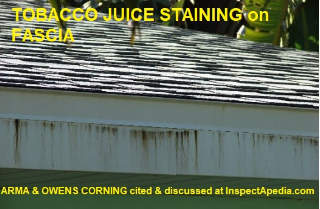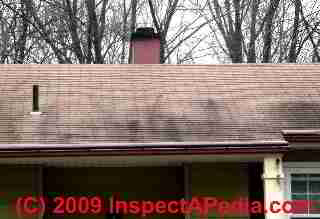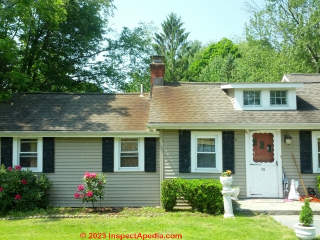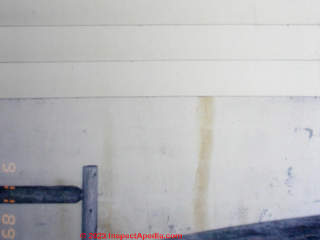 Brown Stains on Asphalt Shingles
Brown Stains on Asphalt Shingles
Tobacco Juicing Stains on Roofs & Building Surfaces
- POST a QUESTION or COMMENT about this article topic
This article describes the cause and significance of brown stains appearing on some asphalt roofing shingles and provides industry research and opinions on the effect of such staining on shingle life.
InspectAPedia tolerates no conflicts of interest. We have no relationship with advertisers, products, or services discussed at this website.
- Daniel Friedman, Publisher/Editor/Author - See WHO ARE WE?
Brown / Tan "Tobacco Staining" on Asphalt Shingles
Roofers, building owners and asphalt roof shingle manufacturers report the presence of a sticky brown staining substance that appears on some asphalt roofing products such as asphalt shingles.
The stains are the result of leaching out of tan or brown water-soluble components in asphalt roof products including not just shingles but also roll roofing, cap sheets, some roof coatings, and some roofing or flashing cement products.
Definition of "Tobacco Juicing Stains"
Tobacco juicing stains are found as brown discoloration on all or parts of roof surfaces as well as more-concentrated brown stains that may appear on surfaces below the roof edge such as on fascia boards (Photo at page top from ARMA who in turn cite Owens Corning, both cited below), gutters, and on the ground at downspout openings.
Here is how GAF describes "Tobacco Juicing"
“Tobacco Juicing” is a naturally occurring phenomenon and refers to a brown sticky substance that may appear on asphaltic roofs and surrounding areas under certain climatic conditions.
Tobacco juicing is not due to either a manufacturing defect or a problem with the asphalt. It generally occurs when a roof is exposed to intense sun combined with excessive night moisture but a prolonged lack of rain." - GAF TAB-R-134
Causes of Tobacco Juicing Stains
- True tobacco juicing stains are oxidized water soluble leachate products found in some asphalt roofing products and that leave a tan or brown stain on the roof surface.
Other airborne particulates and pollutants may combine with and contribute to the visibility of "tobacco juicing roof shingle stains".Other brown stains on roofs that are from different causes include
- Air pollution particulates that may settle on a roof depending on local climates and pollution sources .
Taken alone, these are not "tobacco juice stains"
See STAIN DIAGNOSIS on ROOFS - home
- Organic debris stains on roofs, while usually dark, almost black in color, may also be brown, such as from tannins leaching out of leaves left on roofs.
These are not "tobacco juice stains"
At DEBRIS STAINS on ROOFS - we describe carefully sweeping off this trash to extend the roof life.
See also TREES & SHRUBS, TRIM OFF BUILDING
- RUST STAINS on ROOFS also produce reddish brown stains on various roofing products including asphalt shingles, roll roofing, and cap sheets, almost always near and down-slope from rusted metal sources.
These are not "tobacco juice stains" - Algae stains on roofs, while usually dark or black in color, can also be brown.
See ALGAE, FUNGUS, LICHENS, MOSS on ROOFS
Are Tobacco Juicing Stains a Roofing Defect?
Industry experts such as GAF (cited below) say that the residue that forms these brown stains does not affect the performance of a roof and should not be considered a "performance problem" (which we read to mean "product defect" - Ed.).
Our OPINION is that
- Many homeowners, particularly those who chose a light colored asphalt roof shingle, will consider tobacco juicing staining on roofs at the very least a troubling cosmetic defect.
- While we are seeking and invite contributions of independent research on this product, we worry that the loss of the water soluble component in the asphalt used to impregnate roof shingles (or roofing felt, mastics, sealants) may in fact amend and thus the product's remaining life and durability.
We will want to watch for independent research on that question. There may be more subtle arguments about the real effects of hidden factors in roof life and thus the ultimate cost of roofing to building owners.
Tobacco Juicing Stains from Felt House Wrap?
We sometimes see brown stains on foundation walls below siding on buildings where asphalt-impregnated felt or "roofing felt" was used as a moisture barrier or "house wrap" on the exterior walls, under siding.
When concentrated tan stains show up as in our 1989 home inspection photo above, we think that there is a specific point leak that allows wind-blown rain behind the building siding, and we're alert for other water-related building damage.
Remedy for Tobacco Juicing Stains
The good news is that at least some brown stains such as tobacco juicing on roofs are usually only temporary, appearing on roofs after a dry period, and the stains can be at least reduced if not removed by washing the roof with clean water from a garden hose.
Watch out: we do not recommend power washing asphalt shingle roofs to remove staining. Power washing risks removing mineral granules that form a key part of asphalt shingle or roll roof or cap sheet roofing and that, when lost, mean a shorter remaining roof life.
Atlas Roofing suggests additional measures to reduce the effects of "tobacco juice staining" including those listed below (if they are missing from your roof)
- Add drip edge at roof eaves and rakes to improve the "kick off" of roof drainage away from nearby building surfaces
See DRIP EDGE FLASHING for ROOFS - home - At the lower roof edge / drip edge, extend roof shingles past the roof edge for the maximum usually recommended by shingle manufacturers - 3/4"
- Add drip edge (with a "drip lip") at the edges of parapet walls
- Install gutters to capture and divert roof runoff away from the building
- During long dry periods (especially after the first summer after installation) hose down the roof regularly and hose down exterior surfaces below the roof edge where brown tobacco juicing stains may occur
Watch out: do not try washing your roof yourself unless you know how to use proper fall protection, and do not use a power washer, as we note above.
Special thanks to an InspectApedia.com reader BJ who suggested this topic and several of the references that we cite below, March, 2023.
Research on Tobacco Juicing Stains - Brown Stains on Asphalt Roof Products
- ARMA WATER SOLUZBLE RESIDUE FOUND on ASPHALT ROOFING PRODUCTS ("Tobacco-Juicing") [PDF] (2022) ARMA, Asphalt Roofing Manufacturers Association, 2331 Rock Spring Road
Forest Hill, MD 21050
Tel: (443) 640-1075 under the association's Modified Bitumen Roofing, Residential Roofing, Technical Bulletins, Web: asphaltroofing.org/category/resources/technical-bulletins/modified-bitumen-roofing/ - retrieved 2023/03/09, original source: https://www.asphaltroofing.org/water-soluble-residue-found-on-asphalt-roofing-products-tobacco-juicing/
Excerpt:
The formation of a “tobacco juice” residue, so named for its color, has been widely attributed to the weathering of asphalt roofing (i.e., roof coatings, base and cap sheets, and shingles – to name a few) or the exudation of asphalt fractions from the roofing material.
In fact, similar brown residues have been found on other, non-asphaltic materials, indicating that the phenomenon can be environmental in nature and not wholly attributable to asphalt roofing.
An investigation of this phenomenon concluded that environmental contamination or pollutant deposition was the major contributor to tobacco juicing. Factors commonly present with “tobacco juicing” are excessive air pollution accompanied by nighttime dew conditions and prolonged lack of rain.
Air pollutants can collect on roof surfaces with the formation of dew and subsequently run down onto lower roof surfaces, fascia, and other finish surfaces. F
or steep slope applications, such as asphalt shingled roofs, tobacco juicing may drip off the shingles and stain the adjacent components (see photos 1-3 below for examples). This accumulation of residue can continue until the surfaces are washed or significant rainfall occurs.
The residue typically will not affect the performance of the roof and should not be considered a performance problem. - Atlas Roofing TOBACCO JUICING - How Biological Runoff Can Affect the Look of Shingles [PDF] Atlas Roofing, retrieved 2023/03/09, original source: https://www.atlasroofing.com/asphalt-life/tobacco-juicing
- Berdahl, Paul, Hashem Akbari, Ronnen Levinson, Jeffry Jacobs, Frank Klink, and Rebecca Everman. "Three-year weathering tests on asphalt shingles: Solar reflectance." Solar Energy Materials and Solar Cells 99 (2012): 277-281.
Abstract
Exposed asphalt shingles undergo chemical and physical changes as they weather. Here we focus on the resulting changes in solar reflectance. Most roofing granules employing inorganic metal oxide pigments are very stable.
Initial reflectance changes are therefore due to changes in the asphalt itself, and the loss of processing oils coating the granules. Ultraviolet-induced photo-oxidation of these oils and exposed asphalt produces dark hydrophilic substances that are removed by rain, or in dry climates, transported by dew.
After six months, changes in solar reflectance are small and (in California) mainly due an annual cycle of accumulation of atmospheric dust and its removal by rain.
In hot humid climates cyanobacteria grow rapidly on granule surfaces, creating dark stains that reduce reflectance by as much as 0.06 at 3 years. We show that in these types of climates (exemplified by Houston) biocide additives such as Cu2O can be employed to maintain solar reflectance.
When cyanobacteria are absent, solar reflectance changes over the first three years are on the order of 0.02 or less, and may be either positive or negative.
Excerpt:… brown stains at lower edges and corners after 6 months.
- Berdahl, Paul, Hashem Akbari, Ronnen Levinson, and William A. Miller. "Weathering of roofing materials–an overview." Construction and building materials 22, no. 4 (2008): 423-433.
- GAF, TOBACCO JUICING [PDF] GAF Technical Services, 1 Campus Dr., Parsippany NJU 07054 USA, Tel: 877-423-7663 Web: gaf.com Pub. No. TAB-R-134, retrieved 2023/03/08, original source: gaf.com/en-us/document-library/documents/documents/technicalbulletinsdocuments/residentialenglishdocuments/R__134_Tobacco_Juicing.pdf
- IKO, SHINGLE STAINING - TOBACCO JUICE [PDF] (2014) IKO Roofing, Residential Information Bulletin R-77, March 2014, retrieved 2023/03.08, original source: iko.com/na/document-library/tbr77-tobacco-juice-product-bulletin-en.pdf
Excerpts:
The conditions necessary for the formation of this type of stain are:
1) Intensive sun exposure,
2) Heavy collection of night moisture (dew), and
3) Prolonged lack of rain.
Typically, all three conditions must have occurred. Tobacco Juice generally appears only during the first weathering cycle of the roof, and rarely re-occurs after the first year or rainy season.
There is a different type of discoloration that can sometimes occur with shingles. This other type of shingle staining is caused by diffusion of light oils from the asphalt on the bottom side of the shingles onto the colored granule top surface.
This type of staining generally is the result of prolonged storage of the shingles prior to application. Tobacco Juice results in a similar appearance, but is caused by a different mechanism altogether.
Tobacco Juice residue can be washed off, while shingle staining from light-oils can take months of exposure to break down enough to wash off. The stain is more visible on light colored roofs. In some instances on steep slopes this residue, because it is water soluble, may trickle down off the roof and stain fascia and wall surfaces.
This Tobacco Juice phenomenon does not affect the performance of the roofing material. Industry research has failed to find any ingredient or procedure that would eliminate the occurrence of Tobacco Juice.
Although the residue formation cannot be prevented, gently hosing down any affected surface at regular intervals during long, dry periods of the roof’s first summer after installation can minimize any discoloration associated with Tobacco Juice. - Owens Corning WHY ARE THERE DARK STREAKS ON MY ROOF? [PDF] (2023) Owens Corning, retrieved 2023/03/09, original source: https://www.owenscorning.com/en-us/roofing/blog/algae-resistance
Note that this article is about algae stains on roofs. A search of the OC website did not find use of the phrase "tobacco staining" etc. - Ed.
...
Continue reading at RUST STAINS on ROOFS, or select a topic from the closely-related articles below, or see the complete ARTICLE INDEX.
Or see these
Recommended Articles
- STAIN DIAGNOSIS on ROOFS - home
- ALGAE, FUNGUS, LICHENS, MOSS on ROOFS
- BLACK ROOF STAIN CAUSES
- BLACK or GREEN ALGAE STAINS on ROOFS
- BLACK or GREEN ALGAE STAIN REMOVE / PREVENT
- CHIMNEYS, STAINS on / near
- DEBRIS STAINS on ROOFS
- EXTRACTIVE BLEEDING on SHINGLES
- LICHENS on ROOFS
- MOSS on ROOFS
- POWER WASHING ROOFS
- RUST STAINS on ROOFS
- SOOT STAINS on ROOFS
- TARRY BLEED on ROOFS
- TOBACCO JUICING SHINGLE STAINS
- WHITE STAINS on ROOFS
- TEST LABS - ROOF SHINGLE
Suggested citation for this web page
TOBACCO JUICING SHINGLE STAINS at InspectApedia.com - online encyclopedia of building & environmental inspection, testing, diagnosis, repair, & problem prevention advice.
Or see this
INDEX to RELATED ARTICLES: ARTICLE INDEX to BUILDING ROOFING
Or use the SEARCH BOX found below to Ask a Question or Search InspectApedia
Ask a Question or Search InspectApedia
Try the search box just below, or if you prefer, post a question or comment in the Comments box below and we will respond promptly.
Search the InspectApedia website
Note: appearance of your Comment below may be delayed: if your comment contains an image, photograph, web link, or text that looks to the software as if it might be a web link, your posting will appear after it has been approved by a moderator. Apologies for the delay.
Only one image can be added per comment but you can post as many comments, and therefore images, as you like.
You will not receive a notification when a response to your question has been posted.
Please bookmark this page to make it easy for you to check back for our response.
IF above you see "Comment Form is loading comments..." then COMMENT BOX - countable.ca / bawkbox.com IS NOT WORKING.
In any case you are welcome to send an email directly to us at InspectApedia.com at editor@inspectApedia.com
We'll reply to you directly. Please help us help you by noting, in your email, the URL of the InspectApedia page where you wanted to comment.
Citations & References
In addition to any citations in the article above, a full list is available on request.
- In addition to citations & references found in this article, see the research citations given at the end of the related articles found at our suggested
CONTINUE READING or RECOMMENDED ARTICLES.
- Carson, Dunlop & Associates Ltd., 120 Carlton Street Suite 407, Toronto ON M5A 4K2. Tel: (416) 964-9415 1-800-268-7070 Email: info@carsondunlop.com. Alan Carson is a past president of ASHI, the American Society of Home Inspectors.
Thanks to Alan Carson and Bob Dunlop, for permission for InspectAPedia to use text excerpts from The HOME REFERENCE BOOK - the Encyclopedia of Homes and to use illustrations from The ILLUSTRATED HOME .
Carson Dunlop Associates provides extensive home inspection education and report writing material. In gratitude we provide links to tsome Carson Dunlop Associates products and services.




